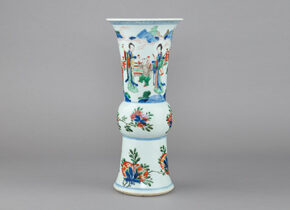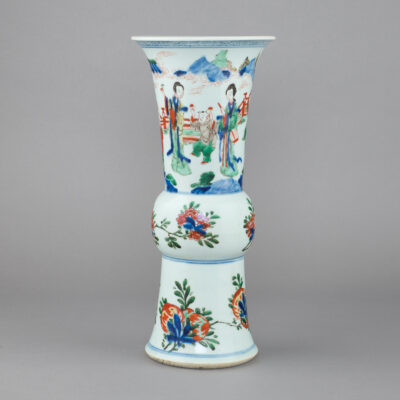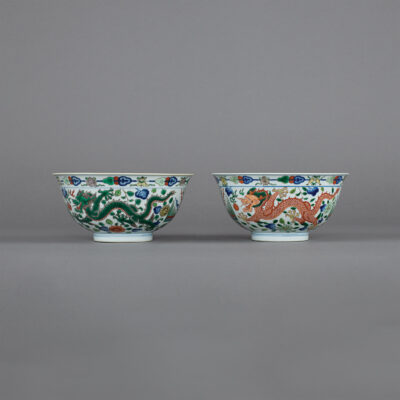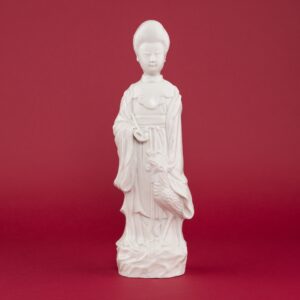


Wucai
Wucai porcelain appeared during the reign of Jiajing, the twelfth Emperor of the Ming dynasty who ruled between 1521 and 1567 and as with much Chinese porcelain, its centre of manufacture was in Jingdezhen, China’s ‘porcelain city.’
With origins in the earlier doucai ceramics, Wucai porcelain is most commonly translated as ‘five colour’ but in fact it often used more or less than five so a more accurate term would simply be ‘multicoloured.’
The traditional manufacturing technique of a Wucai vase, indeed all forms of Wucai porcelain was to first fire the vessel with a blue underglaze for the outline of the design at around 1100°C. Then the vessel was fired a second time once the overglaze of colours including red, blue, purple, yellow and green had been applied at a lower temperature of between 850-900°C.
Thanks to developments in styles and techniques, the production zenith for the Wucai vase and all forms of Wucai porcelain came in the Qing dynasty during the reign of Emperor Kangxi (1661 – 1722) and is characterised by exquisite craftsmanship and intricate decorations including motifs of dragons, flowers, plants, fish and phoenixes. Later examples of Wucai porcelain used gold and black outlines to further enhance the vividly lifelike quality of the pieces.
-

M5397
£9,800A Chinese porcelain wucai cylindrical charcoal burner, hire, painted in a continuous scene, with a seated scholar holding a wine cup in his left hand, whilst resting his right hand on a book, beside wine jars and kang table with a ewer, the reverse with his attendant bringing him a goose, amongst bamboo, plantain, rockwork, fencing and foliage, the enamels painted in bright tones of turquoise, yellow, green and aubergine, heightened in iron-red, all beneath a band of double keyfrets in underglaze blue dispersed between flowering branches and precious objects, and beneath a brown-dressed rim, most of the interior unglaze, all on a short foot rim, the underside with a four character mark, tian xia tai ping, "peace and prosperity under heaven", within a double square.
-

M5540
£POAChinese porcelain wucai vase and cover of meiping form, painted in a continuous scene, from the Romance of the Western Chamber, with a monk at the monastery being visited by a bandit, with Ying Ying and her maidservant Hongnian looking out from beyond a screen, with a bearded figure looking out from a window, the underglaze blue particularly well-drawn with bamboo rockwork and the roof to the entrance of the monastery, the reverse with iron-red cloud banks, the drop over cover painted with lingzhi, aster and bamboo, the gently sloped top with fruiting peach in iron-red beneath the underglaze blue finial.
-

M5630
£7,500Chinese porcelain wucai square-form dish with champfered corners painted in the centre with two phoenix birds in flight on an iron-red cash diaper ground, encircled by sprays of prunus, bamboo, pine and peach flower, the flat everted rim with iron-red keyfret.
-

M5632
£8,500Chinese porcelain wucai, ko akai deep dish, with fluted petal-shaped sides and foliate brown-dressed rim, painted with two pheasants, one standing on rockwork the other swooping down, between flowering peach and peony branches, encircled by an elaborate panelled border, of different geometric grounds including fans, flowerheads, hexagons, scales, lozenge and chain-mail, all heightened with bright green, yellow, turquoise and iron-red enamels; the border of the underside incised in anhua with butterflies and insects, dispersed between flowerheads above further anhua petals at the foot.
-

M5805
£39,500A Chinese porcelain wucai baluster vase and cover, painted with seven standing ladies in a fenced garden scene, three playing musical instruments including; drums, music stone and cymbals, with a central dancing lady, her hands beneath her long sleeves, whilst three other ladies look on, all amongst rock work, a large banana plant, pine, flowers and foliage, beneath a crackled ice band at the shoulder, the neck with iron-red, camellia and rose flower sprays; the cover with two boys playing amongst rock work and plants, the unglazed base with Chinese ink characters, and two further characters on the inside of the cover.
-

M5806
£29,500Chinese porcelain wucai beaker vase, gu, painted on the flared top section with two elegant standing ladies in a fenced garden scene, with four boys playing amongst plantain, rockwork and beneath clouds, mountains and pine in the distance, the lower section with fruiting peach branches, the central bulb with flower spays of camellia and prunus.
-

24 – M5289/90
£POAPair of Chinese imperial porcelain wucai dragon and phoenix bowls, wan, deeply potted with gently flaring rims, each painted on the exterior with an iron-red and a green five-clawed dragon in pursuit of a flaming pearl separated by two swooping phoenix birds amongst leaves and flowerheads in two tones of green, beneath a band of bajixiang alternating with ruyi-heads, above two lines in underglaze blue on the foot. The interior painted in the well with an iron-red five yellow-clawed dragon in pursuit of a flaming pearl amongst flames within two underglaze blue double lines and one at the rim.
-

M5471/2and3
£12,500A set of three Chinese porcelain ko-akae, wucai, polychrome lozenge shape dishes with foliate flutted rims, each painted with a seated figure of Budai, resting against his long staff holding a necklace in his right hand and the edge of his treasure sack, beside the edge of rocky promontory with an overhanging pine tree beneath iron-red cloud within an iron-red border, the rim dressed brown. The base with a two characters mark of Taiping within a double rectangle,
-

M5511
£3,850A Chinese porcelain ko-akai, wucai, square dish, painted in the centre with a crosshatch design of different polychrome grounds including key-fret, cash, tile, scale and chainmail dispersed between iron red flower heads of lotus, prunus and camellia, encircled by a band of butterfly and insects beneath a flat everted rim, painted with crested swirling waves, the chamfered corners with pendent flowers.
-

M4738
£42,000Chinese porcelain wucai four-tiered square picnic box and cover with indented corners, the cover painted with five crane medallions amongst clouds, each side with two chrysanthemum blooms and foliage and each section interior with two orchids, three bases with a six-character mark of Chenghua in iron-red, the flat white biscuit base unglazed.
-

R9225
£9,000A Chinese porcelain famille verte large standing boy holding a vase while a smaller boy climbs his leg, all on a raised square base.























